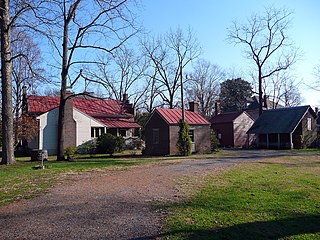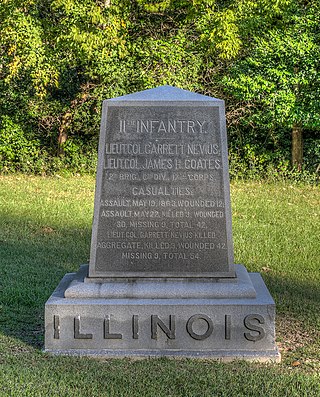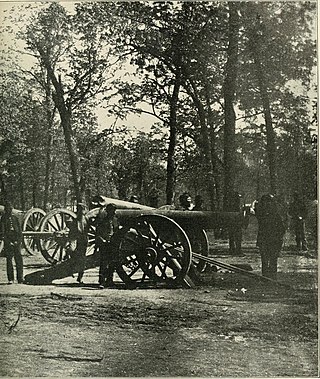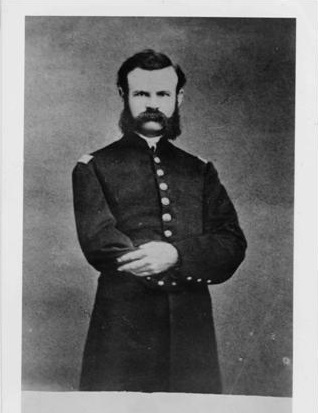
John Alexander McClernand was an American lawyer, politician, and a Union Army general in the American Civil War. He was a prominent Democratic politician in Illinois and a member of the United States House of Representatives before the war. McClernand was firmly dedicated to the principles of Jacksonian democracy and supported the Compromise of 1850.

The Battle of Belmont was fought on November 7, 1861, in Mississippi County, Missouri. It was the first combat test in the American Civil War for Brig. Gen. Ulysses S. Grant, the future Union Army general in chief and eventual U.S. president, who was fighting Major General Leonidas Polk. Grant's troops in this battle were the "nucleus" of what would become the Union Army of the Tennessee.

Kentucky was a southern border state of key importance in the American Civil War. It officially declared its neutrality at the beginning of the war, but after a failed attempt by Confederate General Leonidas Polk to take the state of Kentucky for the Confederacy, the legislature petitioned the Union Army for assistance. Though the Confederacy controlled more than half of Kentucky early in the war, after early 1862 Kentucky came largely under U.S. control. In the historiography of the Civil War, Kentucky is treated primarily as a southern border state, with special attention to the social divisions during the secession crisis, invasions and raids, internal violence, sporadic guerrilla warfare, federal-state relations, the ending of slavery, and the return of Confederate veterans.

The 27th Wisconsin Volunteer Infantry Regiment was an infantry regiment that served in the Union Army during the American Civil War. The regiment began organizing in August 1862 but recruiting problems delayed its entry into federal service until March 1863. Predominantly from the Lake Michigan shore counties of the state, the regiment was mainly composed of German immigrants. The 27th Wisconsin played a supporting role in the Siege of Vicksburg and participated in the capture of Little Rock, Arkansas during the year. The regiment served in the Little Rock garrison and saw its first serious combat in the Camden Expedition of 1864, during which it fought in the Battle of Jenkins' Ferry. The regiment was among the Union forces in the Mobile campaign in early 1865, and was involved in the Battle of Spanish Fort. Ending the war in the occupation of Texas, the regiment was mustered out in August before returning to Wisconsin.
Galvanized Yankees was a term from the American Civil War denoting former Confederate prisoners of war who swore allegiance to the United States and joined the Union Army. Approximately 5,600 former Confederate soldiers enlisted in the United States Volunteers, organized into six regiments of infantry between January 1864 and November 1866. Of those, more than 250 had begun their service as Union soldiers, were captured in battle, then enlisted in prison to join a regiment of the Confederate States Army. They surrendered to Union forces in December 1864 and were held by the United States as deserters, but were saved from prosecution by being enlisted in the 5th and 6th U.S. Volunteers. An additional 800 former Confederates served in volunteer regiments raised by the states, forming ten companies. Four of those companies saw combat in the Western Theater against the Confederate Army, two served on the western frontier, and one became an independent company of U.S. Volunteers, serving in Minnesota.
The 95th Regiment Illinois Volunteer Infantry was an infantry regiment that served in the Union Army during the American Civil War.

The 88th Illinois Infantry Regiment was an infantry regiment from Illinois that served in the Union Army during the American Civil War. The regiment mustered into service in September 1862 and was engaged at Perryville a month later. The unit subsequently fought at Stones River, in the Tullahoma campaign, at Chickamauga, at Missionary Ridge, in the Atlanta campaign, at Franklin, and at Nashville. The 88th Illinois especially distinguished itself at Stones River, Missionary Ridge, and Franklin. The regiment mustered out of service in June 1865.

The 33rd Illinois Infantry Regiment was an infantry regiment from Illinois that served in the Union Army during the American Civil War. A number of the soldiers were college students and graduates, and for a time the regiment included a 17-piece band. The unit fought at Fredericktown in 1861, Cotton Plant in 1862, the Vicksburg campaign and Fort Esperanza in 1863, and at Spanish Fort in 1865. The original enlistees were mustered out in October 1864 while the veterans and recruits were mustered out in December 1865.
The 137th Illinois Infantry Regiment was an infantry regiment from Illinois that served in the Union Army between June 5 and September 4, 1864, during the American Civil War.
The 138th Illinois Infantry Regiment was an infantry regiment from Illinois that served in the Union Army between June 21 and October 14, 1864, during the American Civil War.
The 21st Regiment Illinois Volunteer Infantry was a volunteer infantry regiment that served in the Union Army during the American Civil War.

The 78th Illinois Infantry Regiment was an infantry regiment that served in the Union Army during the American Civil War.

The 114th Illinois Infantry Regiment was an infantry regiment from Illinois that served in the Union Army during the American Civil War. Formed in September 1862, the regiment served in Ulysses S. Grant's Central Mississippi campaign, in the Vicksburg campaign, at Brices Cross Roads, at Tupelo, in the 1864 Missouri campaign, at Nashville, and at Spanish Fort. At Nashville, the unit participated in the decisive attack on Shy's Hill. In 1865, the regiment was reassigned as pontoniers. The regiment was mustered out in August 1865.

The 125th Illinois Volunteer Infantry was an infantry regiment from Illinois that served in the Union Army during the American Civil War. Soon after mustering into Federal service in September 1862, the regiment fought at Perryville. After being stationed at Nashville, Tennessee, the unit briefly fought at Chickamauga and served in the Chattanooga and Knoxville campaigns in 1863. The regiment participated in the Atlanta campaign in 1864, where it took heavy losses at Kennesaw Mountain. It also fought at Peachtree Creek and Jonesborough. At the end of 1864, it served during Sherman's March to the Sea and in 1865 the unit fought in the Carolinas campaign. The regiment participated in the Grand Review of the Armies before being mustered out of service in June 1865.
The 136th Ohio Infantry Regiment, sometimes 136th Ohio Volunteer Infantry was an infantry regiment in the Union Army during the American Civil War.
The 46th Regiment Indiana Infantry was a regiment of the Union Army during the American Civil War.

The 11th Regiment Illinois Volunteer Infantry was an infantry regiment from Illinois that served in the Union Army during the American Civil War. In April 1861, it was formed as a three-month volunteer unit, and in July 1861 it was reorganized as a three-year unit, in which role it served until the end of the war. Two of its commanding officers were promoted to brigadier general and led major units during the war. In its first major action at Fort Donelson the regiment suffered terrible losses. The 11th Illinois also fought at Shiloh, Riggins Hill, Vicksburg, First Yazoo City, Second Yazoo City, and Fort Blakely. In April 1863, the 109th Illinois Infantry Regiment was disbanded and its enlisted men transferred into the 11th Illinois. The regiment was mustered out of service in July 1865.
The 52nd Regiment Indiana Infantry was an infantry regiment that served in the Union Army during the American Civil War.

Battery B, 2nd Illinois Light Artillery Regiment was an artillery battery from Illinois that served in the Union Army during the American Civil War. The battery was organized in June 1861. It fought at Shiloh, First Corinth, and Second Corinth in 1862. Subsequently, the unit garrisoned Corinth, Mississippi, until January 1864. It was stationed at Memphis, Tennessee, until June 1864 when it fought at Brices Cross Roads. The battery garrisoned Memphis until it was mustered out in July 1865.

Battery F, 2nd Illinois Light Artillery Regiment was an artillery battery from Illinois that served in the Union Army during the American Civil War. The battery was organized in December 1861 at Cape Girardeau, Missouri. The unit fought at Shiloh, First Corinth, and Second Corinth in 1862 and at Vicksburg and Jackson in 1863. The battery served in the Atlanta campaign and at Nashville in 1864. It was mustered out of federal service in July 1865. The battery's first commander was John Wesley Powell who later led an exploration of the Grand Canyon.











